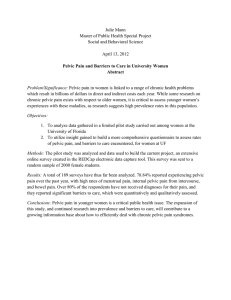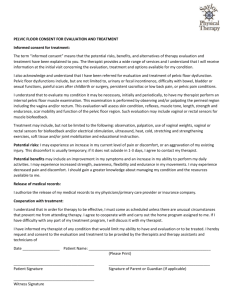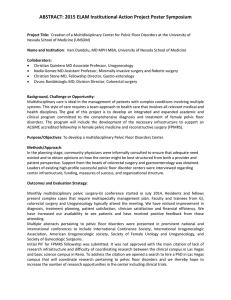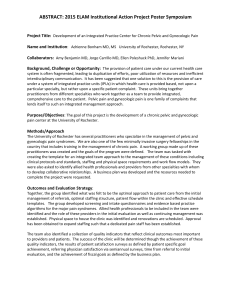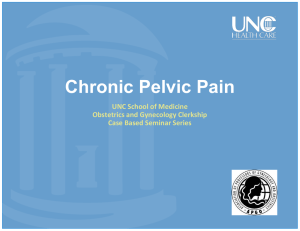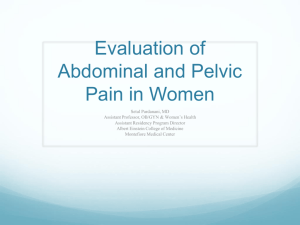CLINICAL CASE
advertisement
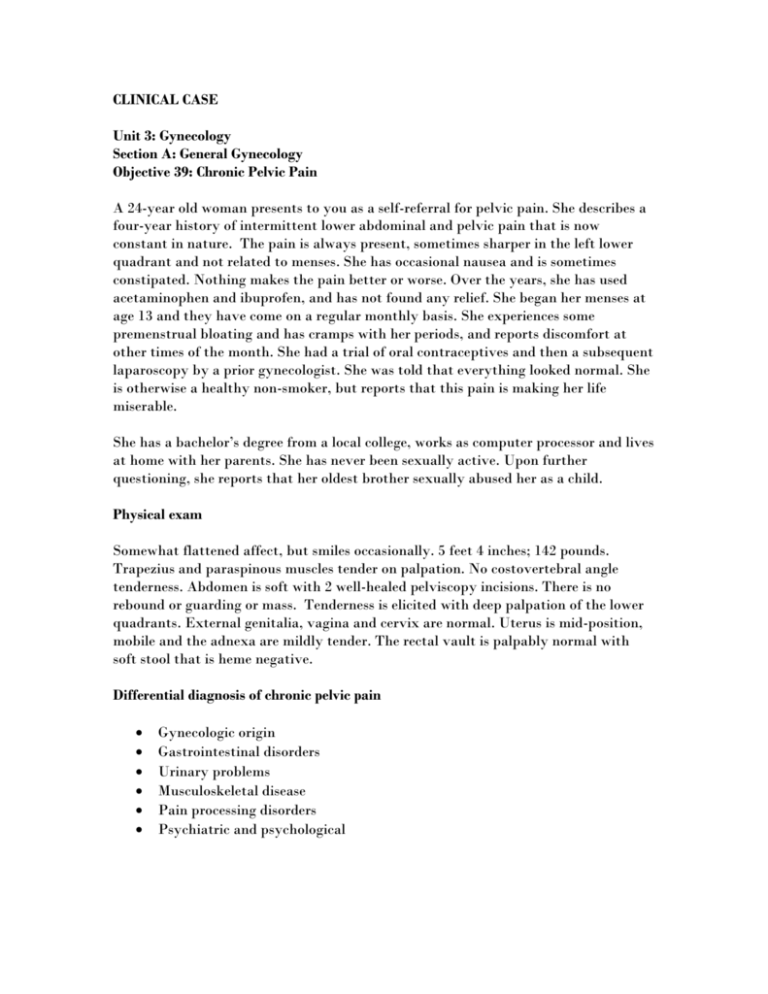
CLINICAL CASE Unit 3: Gynecology Section A: General Gynecology Objective 39: Chronic Pelvic Pain A 24-year old woman presents to you as a self-referral for pelvic pain. She describes a four-year history of intermittent lower abdominal and pelvic pain that is now constant in nature. The pain is always present, sometimes sharper in the left lower quadrant and not related to menses. She has occasional nausea and is sometimes constipated. Nothing makes the pain better or worse. Over the years, she has used acetaminophen and ibuprofen, and has not found any relief. She began her menses at age 13 and they have come on a regular monthly basis. She experiences some premenstrual bloating and has cramps with her periods, and reports discomfort at other times of the month. She had a trial of oral contraceptives and then a subsequent laparoscopy by a prior gynecologist. She was told that everything looked normal. She is otherwise a healthy non-smoker, but reports that this pain is making her life miserable. She has a bachelor’s degree from a local college, works as computer processor and lives at home with her parents. She has never been sexually active. Upon further questioning, she reports that her oldest brother sexually abused her as a child. Physical exam Somewhat flattened affect, but smiles occasionally. 5 feet 4 inches; 142 pounds. Trapezius and paraspinous muscles tender on palpation. No costovertebral angle tenderness. Abdomen is soft with 2 well-healed pelviscopy incisions. There is no rebound or guarding or mass. Tenderness is elicited with deep palpation of the lower quadrants. External genitalia, vagina and cervix are normal. Uterus is mid-position, mobile and the adnexa are mildly tender. The rectal vault is palpably normal with soft stool that is heme negative. Differential diagnosis of chronic pelvic pain Gynecologic origin Gastrointestinal disorders Urinary problems Musculoskeletal disease Pain processing disorders Psychiatric and psychological Management plan The patient was counseled about the multiple possible causes of chronic pelvic pain. The provider was empathic and sensitive in regards to this challenging problem. A plan of care was devised jointly and she was scheduled for a follow-up. The patient’s previous records and operative report was obtained and reviewed. On a subsequent visit, the patient did note that the pain worsens when her older brother returns home for family holidays. She reports that she has never mentioned this to the therapist that she has recently started seeing. A trial of low dose tricyclic antidepressants was initiated which helped the patient with sleeping, but did not make the pain go away. The patient continued to follow up at regularly scheduled intervals with her gynecologist and therapist, and had less emergency room visits. Teaching points Chronic pelvic pain can be defined as cyclic pain of 6 months duration or non-cyclic pain of 3 months duration and the pain interferes with normal activities. The problem of chronic pelvic pain is under-recognized. It may affect 15% to 24% of American women and accounts for a large proportion of office visit time and many invasive surgical procedures. Chronic pelvic pain can be derived from a variety of sources, including gynecologic, gastrointestinal, rheumatologic, musculoskeletal, urologic or psychiatric. It can be difficult to diagnose the etiology and can be challenging to treat. The health care provider must perform a thorough history and physical exam, which are often much more valuable in making a diagnosis than any laboratory or radiologic tests. Patients present to different specialists based on their belief of what is causing the pain. Gastrointestinal diseases may cause symptoms such as nausea, vomiting, bloating or changes in bowel habits. Urinary tract disorders my cause dysuria, urgency or vague pelvic discomfort. Patients need to be asked about fatigue, sleep disturbances, or mood disorders and fibromyalgia and depression considered. Patients also need to be queried about physical and sexual abuse, or any history of substance abuse. Musculoskeletal disorders can be determined by a thorough motor and sensory examination, with attention to the back, hips and legs. Possible gynecologic causes of chronic pelvic pain include endometriosis, adenomyosis, chronic pelvic infection or adhesions. A normal laparoscopy does not completely rule out endometriosis, as the changes can be subtle and occasionally missed. Providers can consider an empiric trial of oral contraceptives or GnRH agonists after nongynecologic causes have been ruled out. Some providers recommend a trial of antibiotics or non-steroidal anti-inflammatories for potential infectious causes. In the case of depression, whether overt or covert, antidepressants should be initiated. Even when the etiology is determined, chronic pelvic pain can be difficult to treat. The patient may need to be seen regularly and provided with much support. Comanagement with a psychologist, social worker or therapist may be helpful.
